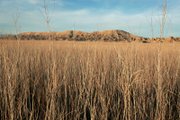Sunday, March 23, 2008 | 2 a.m.
In Today's Sun
Photo Gallery
Fighting an invader
A beetle’s selective appetite for tamarisk trees makes it well suited to fight the invasive plant throughout the West. Up and down the Colorado River the tamarisk now consumes as much as 325 billion gallons of water a year. That’s more water than is used the entire population of the Las Vegas Valley.
Another plant once thought to be a benign shade tree and useful windbreak at campgrounds in Southern Nevada is now in the cross hairs of the National Park Service.
Curt Deuser, a Park Service ecologist, said the athel tree — a cousin to the reviled, invasive tamarisk tree — has begun to spread around Lake Mead. Deuser said the athel, which is also common in parts of Arizona, Southern California and Mexico, was always believed to be noninvasive.
But after a flood in the mid-1980s, athel seeds escaped from campgrounds around Mead and established themselves along remote areas of the lake shore. The tree can be 3 or 4 feet in diameter at the base and can grow 50 to 60 feet tall, much larger than its scrubby cousin. It’s also different from the tamarisk in that it keeps its leaves year round.
But the histories of the plants are similar.
Today the tamarisk is despised for choking riverbanks and recreation areas throughout the Southwest, guzzling precious Colorado River water and ground water and pushing out native plants and animals wherever it grows. But 100 years ago settlers thought the plant was nothing more than a lovely flowering bush that provided shade and a buffer against the wind.
Deuser said scientists hope that by starting the attack on athel relatively early they can prevent it from ever becoming the type of problem tamarisk is now.
“If it becomes invasive, it will consume way more resources, way more water and soil (nutrients) than its cousin,” Deuser said.
The Park Service has removed more than 20,000 athels around Lake Mead already, and plans to kill more, Deuser said.
Tamarisk infestation has spread too far for manual removal methods — such as bulldozers and herbicides — to be effective. Instead, scientists are using a leaf-eating beetle to try to control the tamarisk. When they selected the European beetle and imported it to America, scientists were careful to choose a species that would not eat athel, at the time believing it to be a beneficial tree, according to entomologist Jack DeLoach of the U.S. Agriculture Department.
But athel is not so entrenched that it will take a beetle to control it, Deuser said.
“You don’t want a weed to get like (tamarisk). You’ll never catch up. You need to fight them now, early,” Deuser said. “Here’s our opportunity. A hundred years from now we don’t want to look back and say, ‘Now we need a leaf beetle to eat athel all over six states.’”


Join the Discussion:
Check this out for a full explanation of our conversion to the LiveFyre commenting system and instructions on how to sign up for an account.
Full comments policy